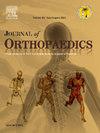伦克 1 型和 2 型青少年特发性脊柱侧凸患者术后骨盆轴旋转过程与肩部平衡之间的关系
IF 1.5
Q3 ORTHOPEDICS
引用次数: 0
摘要
背景青少年特发性脊柱侧凸(AIS)患者的正侧位X光片显示双侧髂骨翼存在差异。这是由于脊柱侧弯引起的骨盆轴旋转(PAR)所致。我们经常会遇到这样的病例:PAR 随手术和术后而发生变化。我们研究了 Lenke 1,2 AIS 患者术前 PAR 的变化过程以及 PAR 与肩部平衡之间的关系。在后正位X光片上测量了PAR和肩部参数。结果 7 名患者(39.3%)在术前进行了 PAR 检查。六名患者(21.4%)的 PAR 在术后 1 周至 2 年间发生了较大变化。从术前到术后不久,旋转没有明显变化,但术后前三个月发生了变化。2年后,旋转组的肩关节明显更平衡(P = 0.025)。旋转组在术后肩部平衡的变化更大(P <0.05)。结论 Lenke 1,2 AIS 患者的 PAR 在术后 3 个月内发生了显著变化。术前有PAR的Lenke 1,2 AIS患者,术后肩部可望恢复平衡。本文章由计算机程序翻译,如有差异,请以英文原文为准。
Relationship between the course of postoperative pelvic axis rotation and shoulder balance in patients with Lenke types 1 and 2 adolescent idiopathic scoliosis
Background
Posteroanterior radiographs of patients with adolescent idiopathic scoliosis (AIS) show bilateral differences in the iliac wings. This is due to pelvic axis rotation (PAR) associated with scoliosis. We often encounter cases wherein the PAR changes with surgery and postoperatively. We investigated the course of preoperative PAR and the relationship between PAR and shoulder balance in patients with Lenke 1,2 AIS.
Methods
In total, 28 patients with Lenke 1,2 AIS undergoing scoliosis correction were included. The PAR and shoulder parameters were measured on posteroanterior radiographs. The correlation between the measured parameters and the extent of changes in each parameter was also examined.
Results
Eleven patients (39.3 %) underwent preoperative PAR. Six patients (21.4 %) showed a greater change in PAR from 1 week to 2 years postoperatively. The rotation did not change significantly from preoperatively to immediately postoperatively but changed during the first three months postoperatively. The rotation group had significantly more balanced shoulders at 2 years (P = 0.025). The rotation group had a greater change in shoulder balance in the postoperative course significantly (P < 0.05). The extent of change in pelvic rotation from 1 week to 2 years postoperatively correlated with the extent of change in shoulder balance.
Conclusion
The PAR in patients with Lenke 1,2 AIS significantly changed during 3 months postoperatively. Patients with Lenke 1,2 AIS with preoperative PAR can be expected to have postoperative shoulder rebalancing.
求助全文
通过发布文献求助,成功后即可免费获取论文全文。
去求助
来源期刊

Journal of orthopaedics
ORTHOPEDICS-
CiteScore
3.50
自引率
6.70%
发文量
202
审稿时长
56 days
期刊介绍:
Journal of Orthopaedics aims to be a leading journal in orthopaedics and contribute towards the improvement of quality of orthopedic health care. The journal publishes original research work and review articles related to different aspects of orthopaedics including Arthroplasty, Arthroscopy, Sports Medicine, Trauma, Spine and Spinal deformities, Pediatric orthopaedics, limb reconstruction procedures, hand surgery, and orthopaedic oncology. It also publishes articles on continuing education, health-related information, case reports and letters to the editor. It is requested to note that the journal has an international readership and all submissions should be aimed at specifying something about the setting in which the work was conducted. Authors must also provide any specific reasons for the research and also provide an elaborate description of the results.
 求助内容:
求助内容: 应助结果提醒方式:
应助结果提醒方式:


